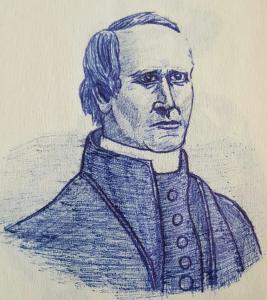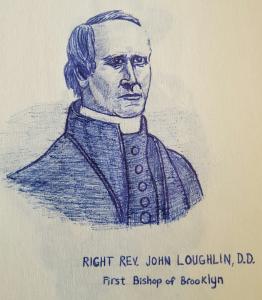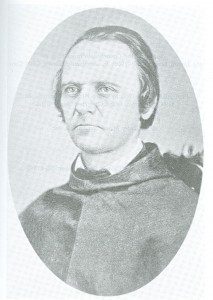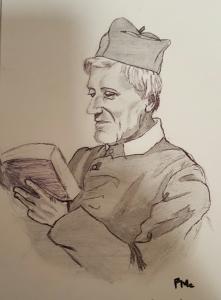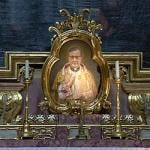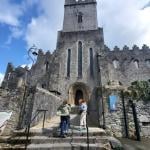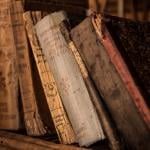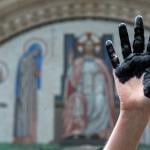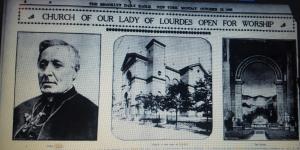
Today is the the Feast of Our Lady of Lourdes, which offers us the opportunity to pay tribute to an old, famed, and beloved Brooklyn parish named in her honor. In its heyday, this parish occupied an entire Brooklyn city block, complete with rectory, parish and school. It was also a pilgrimage site for thousands of New York Catholics for over half a century (even from Manhattan).
In September 1872, the Fathers of Mercy, a French-based religious community, started a new parish in Brooklyn’s Bushwick/East New York section for a growing Catholic population. Thirty families formed the original congregation. Named for St. Francis De Sales, the parish started with a two-room schoolhouse and an old frame building for the church. There was also a priests’ cemetery. The parish, known as the “little French Church,” was actually mostly Irish. Born in France to Italian parents, longtime pastor Father Eugene Porcile. S.P.M. (1839-1912), was called “Father Purcell” by the Irish.

Father Porcile had a strong devotion to Our Lady of Lourdes, then a relatively new devotion in the United States. In 1897, he formally petitioned Brooklyn’s new Bishop, Charles E. McDonnell, to change the parish’s name to Our Lady of Lourdes. McDonnell, who visited the grotto whenever he was in Europe, readily agreed. The parish was soon renamed. Later the street was re-titled De Sales Place to honor the parish’s pioneer years.
A new, imposing church was soon erected, believed to be the first shrine church in America dedicated to Our Lady of Lourdes. One of its most prominent features was described in the pages of The Brooklyn Eagle in 1898:
Behind the altar there is a representation to imitate the famous grotto at Lourdes. There is a structure some thirty feet in height of imitation rocks and shrubs. There is a cave in the center about ten feet in height and extending back some fourteen feet. At a corner above stands the Virgin Mary as she stood, according to the story, when she first appeared to the little girl Bernadette and performed the first Lourdes miracle. On the opposite side stands Bernadette herself.
Within a year of the parish’s redesignation, By 1898, the Eagle noted, that “thousands of people are making pilgrimages to the church” from all across the city. For those who couldn’t afford to make it to France, indulgences were granted “as if the petitioner had journeyed to the distant shores of France.” By 1899, special Masses began to be offered for the sick on a regular basis.

For decades the church, described as “one of the handsomest in Brooklyn,” and its grotto were a center for local devotions. Brooklyn’s Holy Name Societies annually brought crowds of 2,000 to 2,500 local Catholic men by the turn of the century. In 1910, the Eagle called it “a shrine for many devout pilgrims from all sections of the city.” The parish was known as “the Grotto Church.”
By the 1920’s, one writer noted the parish offered blessings of the sick every Wednesday afternoon. “The clatter of the elevated.” it was observed, “and the roar of Broadway traffic are forgotten, and distant Lourdes is recreated in an alien land.” The author concluded:
Those who lament that life in America today has lost all color and all poetry might well visit the Church of Our Lady of Lourdes, where candles burn perpetually and France is born anew in Brooklyn.
By the early 1960’s, the Fathers of Mercy had withdrawn from the parish. As the decade progressed, the neighborhood changed greatly, as longtime parishioners died or moved away. Pilgrimages to Our Lady of Lourdes fell off considerably. In 1974, the much-beloved church building burned to the ground. Later the parish was merged with nearby St. Martin of Tours, founded in 1906.
Today, Bushwick is a hot spot for gentrification, but I wonder how many newcomers know the neighborhood history. The story of Our Lady of Lourdes brings us from the years when Bushwick was scattered farms, through the years of the “old neighborhood,” when locals identified themselves by parish rather than region, when thousands flocked to Aberdeen Street to experience a bit of France in Brooklyn.
(*The above drawings of Father Porcile and the parish are taken from the pages of The Brooklyn Eagle, which operated from 1841 to 1955.)


